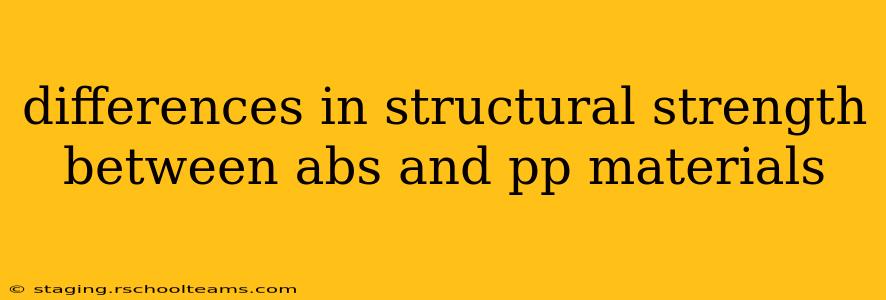ABS vs. PP: A Deep Dive into Structural Strength Differences
Choosing the right material for a product often hinges on its structural strength. Acrylonitrile Butadiene Styrene (ABS) and Polypropylene (PP) are both popular thermoplastic polymers, but they exhibit significant differences in their structural properties. Understanding these differences is crucial for engineers and designers selecting materials for various applications. This article will delve into the key distinctions between ABS and PP in terms of their structural strength, exploring their mechanical properties and suitability for different applications.
What are the key mechanical properties that define structural strength?
Before comparing ABS and PP, let's define the key mechanical properties that dictate structural strength:
- Tensile Strength: This measures a material's resistance to being pulled apart. Higher tensile strength indicates greater resistance to stretching and breaking under tension.
- Flexural Strength: This indicates a material's resistance to bending or flexing. It's crucial for applications requiring rigidity and resistance to deformation.
- Impact Strength: This assesses a material's ability to withstand sudden impacts or shocks without fracturing. High impact strength is essential for durable products.
- Hardness: This refers to a material's resistance to indentation or scratching. A harder material is generally more resistant to wear and tear.
- Stiffness (Young's Modulus): This measures a material's resistance to deformation under stress. A higher Young's Modulus indicates greater stiffness and rigidity.
How does ABS compare to PP in terms of these properties?
Generally, ABS exhibits superior strength in tensile, flexural, and impact tests compared to PP. This is due to its composition: ABS is a terpolymer, combining the properties of acrylonitrile (providing rigidity and chemical resistance), butadiene (contributing impact resistance and flexibility), and styrene (enhancing its strength and processability). PP, a simpler homopolymer, while possessing good properties, typically shows lower strength values across the board.
However, it's crucial to avoid generalizations. The specific mechanical properties of both ABS and PP can vary significantly depending on factors such as:
- Grade: Different grades of ABS and PP exist, each tailored for specific applications and possessing slightly different properties. High-impact grades of both materials will demonstrate better strength characteristics than standard grades.
- Additives: The addition of fillers, such as glass fibers or talc, can significantly enhance the structural strength, stiffness, and other properties of both ABS and PP.
- Processing conditions: The way the material is processed—injection molding, extrusion, etc.—can also affect its final mechanical properties.
What are the typical applications where ABS excels due to its superior strength?
ABS's superior strength makes it ideal for applications requiring high impact resistance and durability. Examples include:
- Automotive parts: Interior and exterior components, dashboards, housings.
- Consumer electronics: Cases for appliances, computers, and mobile phones.
- Luggage: Suitcases and other travel bags.
- Pipes and fittings: Applications where impact and chemical resistance are critical.
What are typical applications where PP is preferred, even with its lower strength?
Despite its lower strength compared to ABS, PP offers other advantages that make it suitable for specific applications:
- Lightweight applications: PP is significantly lighter than ABS, making it ideal for applications where weight is a critical factor, such as automotive parts or packaging.
- Cost-effectiveness: PP is generally less expensive than ABS, making it a more economical choice for high-volume applications.
- Chemical resistance: PP demonstrates excellent chemical resistance to many substances, making it suitable for applications involving corrosive environments.
- Food contact applications: Many PP grades are approved for food contact, making them suitable for food containers and packaging.
Does the addition of fillers significantly alter the strength comparison?
Yes. The addition of fillers, especially glass fibers, can dramatically improve the structural strength and stiffness of both ABS and PP. Fiber-reinforced grades of both materials can significantly outperform their standard counterparts, sometimes closing the gap or even surpassing ABS's inherent strength advantages in specific properties. The choice between filled ABS and filled PP would then depend more on other factors such as cost, chemical resistance, and desired final properties.
In conclusion:
While ABS generally exhibits superior structural strength compared to PP in various tests, the optimal material choice depends heavily on the specific application and its requirements. Factors like cost, weight, chemical resistance, and the potential for filler additions all play a significant role in the final decision. Careful consideration of all these factors is crucial for selecting the most appropriate material.
